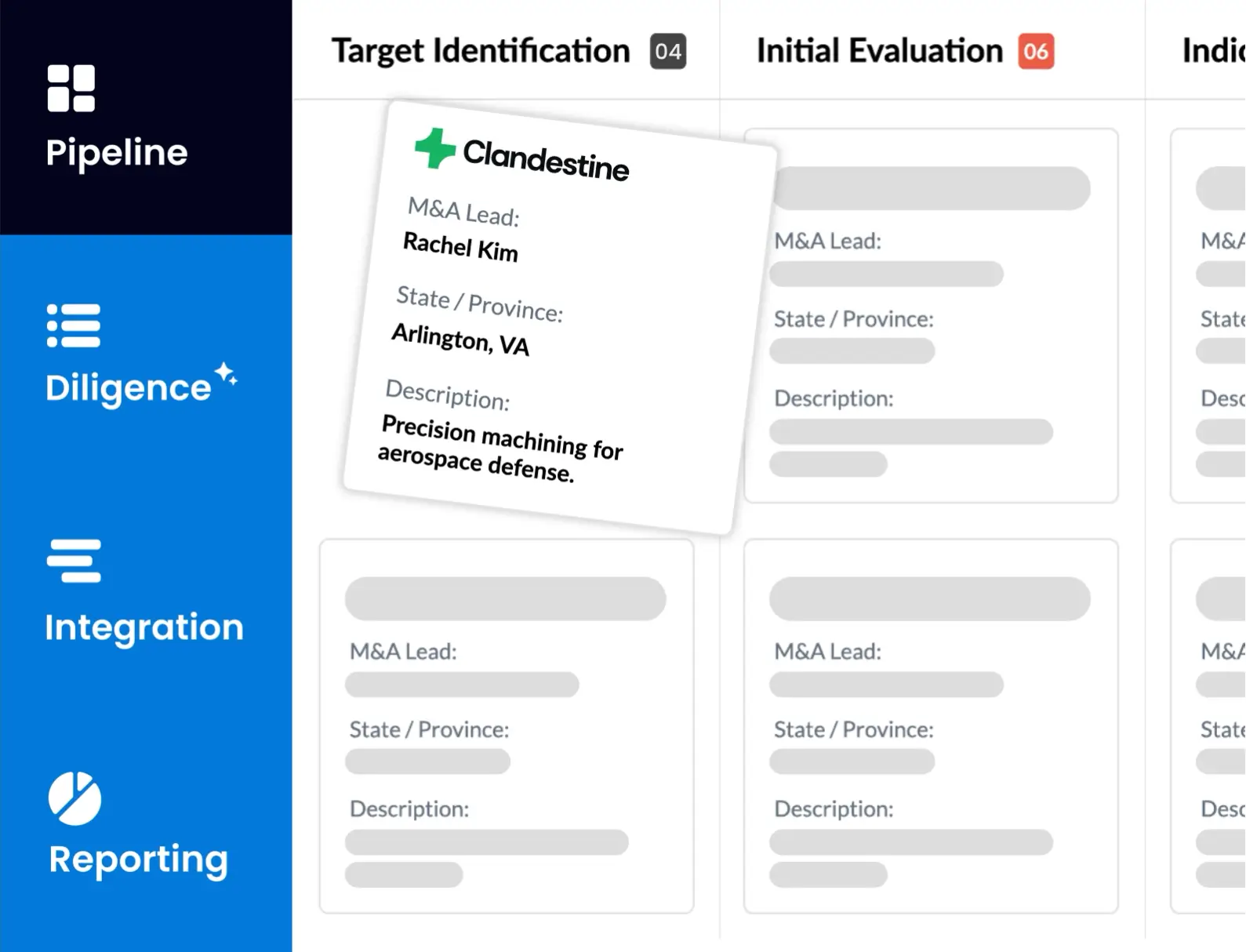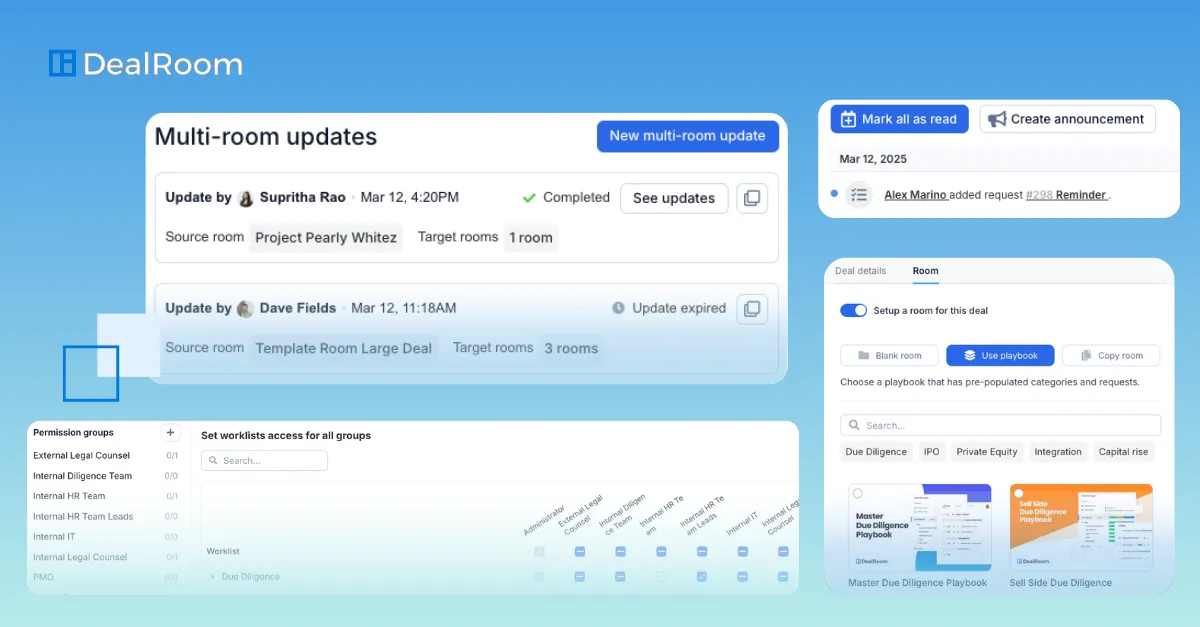When companies consider acquiring another business, they need a clear picture of what they're buying. They also need to determine whether the deal makes sense. That’s why buy-side commercial due diligence is a crucial component of any deal.
The due diligence process extends beyond basic financial reviews, examining customer relationships, market dynamics, and operational capabilities to help buyers understand the opportunities and risks associated with a potential transaction. Companies use this analysis to validate their investment thesis and to determine fair pricing. The process typically includes market research, customer interviews, competitive analysis, and operational assessments.
Commercial due diligence provides critical data for business valuation. It helps buyers make informed decisions about complex transactions. Without proper due diligence, acquiring companies risk overpaying for assets or overlooking important red flags that could impact future performance.
In this article, we’ll explore the buy-side commercial due diligence process, including its core components, the differences between buy-side and sell-side due diligence, critical areas of valuation, and best practices for conducting comprehensive buy-side commercial due diligence.
In this article:
What is Buy-Side Commercial Due Diligence?
Buy-side commercial due diligence is a comprehensive analysis that acquiring companies conduct to evaluate a target company's market position, competitive advantages, and growth potential before completing a transaction. This process extends beyond financial statements, delving into the realities of the target’s operating environment.
Key elements often include customer and supplier landscapes, industry trends, pricing power, and potential disruptors. The aim is to provide the buyer with a comprehensive and realistic picture of the business’s future performance and to validate or challenge the assumptions underpinning the deal’s valuation.
For corporate development teams and private equity investors, this work is often at the heart of the deal strategy. It is used to test revenue forecasts, market share assumptions, and identify risks that could impact value, such as changing regulations, new entrants, or shifting consumer preferences. The findings from commercial due diligence can also help shape the deal structure, purchase price, and post-merger integration plans, making it a critical early step in the acquisition process.
Understanding the Buy-Side Commercial Due Diligence Process

Buy-side commercial due diligence involves systematic evaluation processes and distinct team roles. There are some key differences from sell-side approaches.
The due diligence process in M&A transactions follows a structured approach to evaluate target companies. The buyer initiates a comprehensive analysis across multiple business areas.
Key process stages include:
- Initial target identification and screening
- Information gathering and document review
- Risk assessment and business validation
- Financial analysis and projections
- Final recommendations and decision-making
The acquisition process typically spans 8 to 12 weeks, depending on the deal's complexity. Outlining strategic goals for the due diligence process is essential for success.
Due diligence teams focus on business risks during evaluation. They examine operational performance, market position, and growth potential.
The process validates assumptions made during the initial target assessment.
Buy-Side vs. Sell-Side Due Diligence: Key Differences
Buy-side due diligence teams represent prospective buyers, while sell-side teams assist business owners. The buyer has more time for thorough evaluation in buy-side scenarios.
Buy-side due diligence serves different purposes than sell-side approaches. The buyer controls timing, scope, and depth of analysis during buy-side acquisitions.
Buy-side characteristics include:
- Buyer-initiated and controlled process
- Focus on investment risks and opportunities
- Detailed operational and strategic analysis
- Timeline driven by acquisition goals
Sell-side characteristics include:
- Seller-managed process
- Emphasis on company strengths
- Limited scope and timeframe
- Multiple buyer engagement
Information access differs significantly between approaches, with buy-side due diligence allowing for deeper investigation into problem areas.
Essential Due Diligence Team Members
The due diligence team requires specific expertise across multiple disciplines. Each member brings unique skills to evaluate different business aspects.
The table below highlights the core team structure for a buy-side commercial due diligence team.
Commercial due diligence plays a key role in the overall evaluation. Technical experts may join for industry-specific assessments.
The team size varies based on the deal complexity and the target company's size. Smaller deals typically require 3-5 team members, while larger transactions may require 8-12 specialists. External advisors, such as investment banks, consultants, and specialized firms, often supplement internal capabilities, providing additional expertise when needed.
Critical Areas of Evaluation in Buy-Side Commercial Due Diligence

Buy-side commercial due diligence requires a systematic evaluation across four critical domains: financial performance analysis, operational efficiency assessment, analysis of the target company’s market positioning, and verification of regulatory compliance. Each area provides essential insights that directly impact acquisition decisions and post-deal success.
Financial Due Diligence Essentials
Financial due diligence forms the foundation of any acquisition evaluation. Buyers must verify the accuracy of financial statements and assess the target company's true financial health.
Cash flow analysis represents the most critical component. Acquirers examine historical cash flows, seasonal variations, and working capital requirements. Free cash flow calculations reveal the company's ability to generate value after necessary investments.
Asset value verification requires a detailed review of balance sheet items. Property valuations, inventory assessments, and accounts receivable aging provide clarity on actual worth versus book value.
Key financial metrics include:
- EBITDA margins and trends
- Debt-to-equity ratios
- Return on invested capital
- Working capital cycles
Revenue quality analysis examines customer concentration, contract terms, and the distinction between recurring and one-time sales. This evaluation helps predict future performance stability.
The due diligence data room typically contains three to five years of audited financials, monthly management reports, and detailed budget forecasts. Buyers should request supplementary schedules for significant transactions or changes in accounting policy.
Operational Due Diligence Strategies
Operational due diligence evaluates the target's ability to execute its business model effectively. This assessment directly impacts deal structure and integration planning.
A management team evaluation assesses leadership depth, retention risks, and succession planning. Key personnel contracts, compensation structures, and non-compete agreements require careful review.
Process efficiency analysis identifies operational strengths and weaknesses. Buyers assess production capabilities, quality control systems, and the reliability of the supply chain.
The table below breaks down the critical operational areas.
Synergy identification helps justify the acquisition premium. Cost savings opportunities, revenue enhancement potential, and shared resource benefits influence valuation models.
Operational risks such as single-source suppliers, aging equipment, or regulatory compliance gaps can significantly impact deal value and timing.
Assessing Commercial and Market Factors
Market analysis provides context for the acquisition target's competitive position and growth prospects. Understanding industry dynamics shapes long-term value creation expectations.
Competitive Landscape Evaluation
Competitive landscape evaluation examines market share trends, competitor strategies, and barriers to entry. This analysis helps predict future competitive pressures and pricing power.
Customer analysis reveals revenue concentration risks and the strength of relationships. Contract terms, customer satisfaction scores, and retention rates are key indicators of business stability.
Market factors to evaluate include:
- Industry growth rates and cyclicality
- Regulatory changes affecting the sector
- Technology disruption threats
- Geographic market dynamics
Product Positioning Assessment
A product positioning assessment examines the target's offerings against alternatives. Unique value propositions, pricing strategies, and innovation capabilities influence future competitiveness.
Distribution channel analysis reveals market access strengths and dependencies. Direct sales capabilities, partner relationships, and digital marketing effectiveness impact growth potential. Market research data, industry reports, and customer interviews provide external validation of management's growth projections and strategic assumptions.
Tax and Compliance Considerations
Tax due diligence identifies liabilities, planning opportunities, and compliance risks that affect deal economics. Tax considerations often significantly influence decisions regarding deal structure.
A historical compliance review examines filed returns, audit histories, and outstanding disputes. Unresolved tax positions can create contingent liabilities that impact purchase price negotiations.
Tax planning opportunities emerge from combining the target with the acquirer's existing operations. Different jurisdictions, loss carryforwards, and depreciation methods may create value through optimization.
Key compliance areas include:
- Employment taxes - Payroll compliance, contractor classifications
- Sales taxes - Multi-state obligations, exemption certificates
- Income taxes - Transfer pricing, consolidated returns
- Property taxes - Asset valuations, exemption eligibility
International operations add complexity through foreign tax credits, repatriation strategies, and treaty benefits. Cross-border structures require specialized expertise to optimize tax efficiency.
Deal structure implications include asset versus stock purchases, tax-free reorganizations, and installment sale elections. These decisions affect both parties' tax positions and cash flows.
Regulatory compliance extends beyond taxes to include industry-specific requirements, environmental obligations, and adherence to labor laws. These factors influence ongoing operational costs.
Risk Identification and Value Creation in Buy-Side Commercial Due Diligence

Buy-side commercial due diligence enables buyers to identify potential deal-breakers and uncover hidden value in acquisition targets. Buyers must balance risk assessment with accurate valuation of growth potential and financial performance.
Detecting Red Flags and Liabilities
Experienced buyers use commercial due diligence investigation reports to identify material risks that could derail deals. Red flags often appear in financial inconsistencies, customer concentration, or regulatory compliance issues.
Key red flags include:
- Revenue recognition irregularities
- Major customer dependencies (>20% of revenue)
- Pending litigation or regulatory investigations
- Declining market share trends
- Management team departures
Competitive analysis reveals market position weaknesses. Buyers assess whether new competitors or technology disruption threaten the target.
Financial red flags need immediate attention. Cash flow manipulation, unusual accounting practices, or unexplained expenses often signal deeper financial problems.
Due diligence teams also look for operational risks. Supply chain vulnerabilities, key employee dependencies, or outdated systems can create post-acquisition challenges.
Identifying Growth Opportunities
Smart buyers use buy-side due diligence to find value creation potential beyond current performance. Growth opportunities often exist in underexploited markets, operational improvements, or strategic synergies.
Common growth drivers include:
- Geographic expansion opportunities
- New product development potential
- Operational efficiency improvements
- Cross-selling to existing customers
- Technology integration benefits
Market analysis reveals untapped customer segments or regions. For instance, the target may have strong capabilities but limited market penetration.
Operational improvements can create immediate value. Buyers seek improved processes, technology, or management practices to enhance performance.
Strategic synergies between buyer and target multiply growth potential. These synergies can involve shared distribution channels, complementary products, or combined research and development (R&D) capabilities.
Validating Asset Value and Cash Flow
Financial due diligence verifies asset value and cash flow projections, distinguishing between one-time gains and recurring revenue streams. Asset validation covers both tangible and intangible value. Real estate, equipment, and inventory need physical verification and market appraisals.
Cash flow analysis covers:
- Revenue sustainability and growth rates
- Cost structure and margin trends
- Working capital requirements
- Capital expenditure needs
- Debt service capabilities
Historical cash flow patterns reveal seasonal or cyclical trends. Buyers adjust projections based on these patterns and current market conditions. Quality of earnings analysis removes non-recurring items to identify the target's normalized earning capacity and sustainable cash generation.
Working capital analysis determines funding needs for growth. Some targets require substantial investment in inventory or receivables to sustain operations.
Transaction Execution and Advisory Best Practices
Professional transaction execution depends on strategic coordination, secure information management, and tailored assessment frameworks. These elements build the foundation for successful buy-side commercial due diligence.
Leveraging Transaction Services and Advisory
Transaction advisory firms offer expertise that buy-side teams may lack internally. These professionals bring industry knowledge and standardized processes to complex deals.
Key advisory services include:
- Financial modeling and valuation support
- Market analysis and competitive positioning
- Risk assessment and mitigation strategies
- Deal structure optimization
Private equity firms often engage multiple advisory specialists simultaneously. This ensures coverage of technical, commercial, and operational aspects.
The buy-side M&A process relies on coordinated advisory support. Teams set clear communication protocols between internal stakeholders and external advisors.
Effective advisory relationships require defined scope boundaries. Each advisor needs to understand their deliverables and reporting requirements to avoid overlap or gaps.
Utilizing Secure Data Rooms
Data rooms serve as the central hub for exchanging all due diligence information. Modern virtual data rooms offer enhanced security features and real-time collaboration tools.
Essential data room features include:
- Multi-factor authentication
- Document watermarking
- User activity tracking
- Version control systems
- Mobile accessibility
Buy-side teams should set data room protocols early in the process. This includes user permissions, document organization, and procedures for information requests.
Proper data room management speeds up due diligence. Organized folder structures and clear naming conventions enable advisors to quickly locate critical information.
Security protocols must strike a balance between access and confidentiality. Teams should audit user access and monitor document downloads throughout the process.
Customizing the Due Diligence Checklist for Your Deal
Generic due diligence checklists often miss industry-specific risks and opportunities. Customization ensures comprehensive coverage of deal-relevant factors.
Checklist customization elements include:
- Industry regulatory requirements
- Technology infrastructure assessments
- Customer concentration analysis
- Supply chain dependencies
- Competitive landscape evaluation
The due diligence process should align with the buyer's investment thesis. Priority areas receive deeper analysis, while standard items follow streamlined procedures.
Teams must strike a balance between thoroughness and time constraints. Critical path items should be identified and prioritized to avoid delays, and regular checklist updates help capture emerging issues as new information appears.
Frequently Asked Questions
What are the key components of a commercial due diligence process in M&A transactions?
The commercial due diligence process includes market analysis, customer assessment, and revenue validation. Teams examine historical financial performance and future growth projections.
Product positioning analysis helps buyers understand the competitive advantages of a product. Management interviews reveal operational strengths and weaknesses affecting valuation.
Technology assessment covers systems integration and scalability. A regulatory compliance review identifies potential legal risks that could impact the deal.
How do we assess the competitive landscape during buy-side commercial due diligence?
Market share analysis compares the target company against competitors. Teams evaluate pricing strategies and customer retention rates.
Competitive positioning studies examine product differentiation and brand strength, and barrier-to-entry assessment identifies threats from new entrants. Teams thoroughly evaluate technology gaps and competitive advantages.
What financial ratios are critical to analyze in the due diligence process?
Profitability ratios, including gross margin, operating margin, and net profit margin, are key trends to monitor. Return on equity and return on assets are indicators of management effectiveness.
Liquidity ratios, such as the current ratio and the quick ratio, indicate a company's short-term financial health. Debt-to-equity ratios reveal leverage levels and financial risk. Working capital metrics show cash flow efficiency, while revenue growth rates and customer concentration ratios are key indicators of business sustainability.
What are common risks identified during commercial due diligence that could affect a deal's value?
Customer concentration risk arises when a small number of clients generate the majority of revenue, while technology obsolescence poses a significant threat to companies in rapidly evolving industries.
Regulatory changes can also affect profitability, and key person dependency creates operational risks if critical employees leave. Market saturation limits growth potential and competitive positioning, while supply chain disruptions affect manufacturing and distribution capabilities.
How does vendor due diligence differ from buy-side due diligence?
Vendor due diligence is initiated by the seller and shared with multiple buyers, while buy-side due diligence is conducted by the acquiring company. Vendor reports usually present favorable information and highlight strengths.
Buy-side analysis involves independent verification and risk assessment, with a focus on the buyer's interests. The timing also differs: vendor due diligence occurs before marketing begins, while buy-side reviews take place during active negotiations and necessitate a more thorough investigation.
What is typically included in the scope of work for financial due diligence?
The financial due diligence scope includes an analysis of historical financial statements, as well as a review of accounting policies. Cash flow verification and working capital analysis give operational insights, and tax structure examination identifies potential liabilities and optimization opportunities.
Debt analysis covers covenant compliance and refinancing requirements. Budget variance analysis shows forecasting reliability and helps assess management competence levels. Evaluators also assess management reporting systems for accuracy and completeness.
Key Takeaways
- Buy-side commercial due diligence helps acquiring companies evaluate target businesses before completing transactions.
- The process examines market position, competitive advantages, customer relationships, and growth potential beyond basic financials.
- Proper due diligence reduces transaction risks and helps buyers determine fair pricing for acquisitions.
Buy-side commercial due diligence gives buyers insight into the target company’s markets, customers, and operations. It helps buyers ensure that they’re not overpaying, and validates a target’s market position and growth potential. Investigating customer relationships, market dynamics, operational efficiency, and regulatory risks enables buyers to base their decisions on facts, rather than assumptions.
DealRoom streamlines this process, making it faster and more organized. The DealRoom M&A platform provides a secure and centralized location for exchanging documents, tracking requests, and maintaining real-time visibility into due diligence progress for entire teams. Buyers don’t have to chase down emails and update spreadsheets. Instead, they can focus on analysis and negotiations. DealRoom helps move due diligence from initial screening to final recommendation faster and more efficiently, supporting better valuations and closings. Request a demo to learn how DealRoom can streamline your M&A lifecycle.



















.png)
.webp)



.webp)
.webp)
.webp)





.png)
.png)
.png)
.svg)

.svg)
.png)
